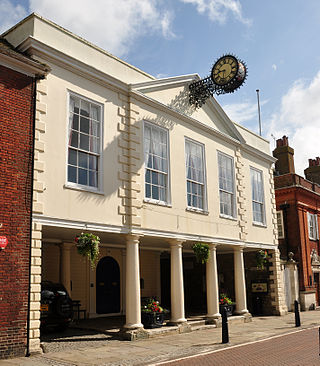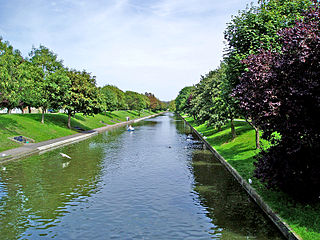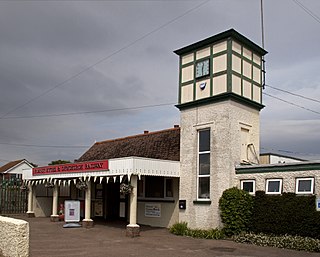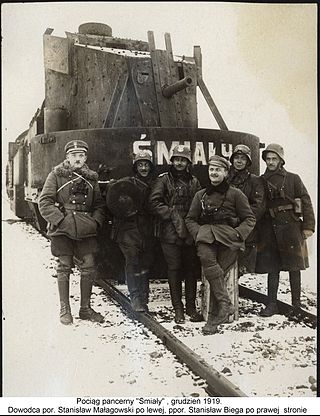
The Romney, Hythe and Dymchurch Railway (RH&DR) is a 15 in gauge light railway in Kent, England, operating steam and internal combustion locomotives. The 13+1⁄2-mile (21.7 km) line runs from the Cinque Port of Hythe via Dymchurch, St. Mary's Bay, New Romney and Romney Sands to Dungeness, close to the Dungeness nuclear power stations and Dungeness Lighthouse. The line is double track north of New Romney and single track south.

Romney Marsh is a sparsely populated wetland area in the counties of Kent and East Sussex in the south-east of England. It covers about 100 square miles (260 km2). The Marsh has been in use for centuries, though its inhabitants commonly suffered from malaria until the 18th century. Due to its location, geography and isolation, it was important for smugglers between the 17th and 19th centuries. The area has long been used for sheep pasture: Romney Marsh sheep are considered one of the most successful and important sheep breeds. Featuring numerous waterways, and with some areas lying below sea level, the Marsh has over time sustained a gradual level of reclamation, both through natural causes and by human intervention.

Hythe is a market town and civil parish on the edge of Romney Marsh, in the district of Folkestone and Hythe in Kent, England. The word Hythe or Hithe is an Old English word meaning haven or landing place.

An armoured train or armored train is a railway train protected with heavy metal plating and which often includes railway wagons armed with artillery, machine guns, and autocannons. Some have also had ports used to fire small arms from the inside of the train, especially in earlier armoured trains. For the most part, they were used during the late 19th and the early 20th centuries, when they offered an innovative way to quickly move large amounts of firepower into a new location.

Dymchurch Grand Redoubt is a fortification at Palmarsh on the coast of Kent in England, built during the Napoleonic War as part of a large defensive scheme to protect the country from an expected French invasion.

Dymchurch is a village and civil parish in the Folkestone and Hythe district of Kent, England. The village is located on the coast five miles (8 km) south-west of Hythe, and on the Romney Marsh.

The Devon and Cornwall County Division was a County Division of the British Army created during the Second World War. It was formed on 28 February 1941, from recently recruited soldiers, in response to the renewed threat of a German invasion. The 10,000-strong division was a static formation, lacking transport, intended to defend possible landing sites along the southern Cornish and Devon coastlines from invading German troops. The creation of the division also helped to free up the more experienced troops, who were then held back from the coastline to be able to launch a counterattack against any potential German landings.

The Royal Military Canal is a canal running for 28 miles (45 km) between Seabrook near Folkestone and Cliff End near Hastings, following the old cliff line bordering Romney Marsh, which was constructed as a defence against the possible invasion of England during the Napoleonic Wars.

Hythe station is the northern terminus of the Romney, Hythe and Dymchurch Railway. The station has curved platforms with an overall roof, loco release road, former engine shed, signalbox with 16 lever frame, and a turntable. In terms of passenger bookings Hythe is the busiest station on the railway.

New Romney railway station is a station on the Romney, Hythe and Dymchurch Railway in New Romney, Kent, England. It has always been the headquarters location of the railway.

The Pilot Inn railway station was a station on the Romney, Hythe and Dymchurch Railway in Kent, England.

The War Department halt was an informal railway station on the Romney, Hythe and Dymchurch Railway in Kent, England. Over the 15 years that the station was open, its location is believed to have moved several times. Details are scarce as this was a secret military installation, but the end of the War Department branch line moved as building work moved onto new stages. When the installation closed in 1945 the railway company took over the line for freight shipment of ballast. Again, the end point of the line changed several times as the exact location of extraction of ballast changed, until closure of the branch in 1951. The locations of the halt are now under water owing to subsequent commercial extractions and flooding of the ballast pits.

The armoured train Śmiały, sometimes PP 53 and officially Armoured Train number 53 was an armoured train of the Polish Army that saw significant action during the German Invasion of Poland in September 1939. The train in the end served under four flags—Austrian, Polish, Soviet, German—and fought in several wars from 1914 to 1945. Śmiały distinguished itself in the Battle of Mokra, after which it withdrew eastwards, taking part in the Battle of Brześć Litewski. After the Soviet invasion of Poland on September 17, the train left the western front via Kowel to Lwów, where it fought in the Battle of Lwów. On September 22, 1939, abandoned by its crew, it was seized by the Red Army.

Piłsudczyk was a Polish armoured train of the early 20th century. It was among the first armoured trains serving the Polish Army and took part in the Polish-Ukrainian War of 1918-1919, the subsequent Polish-Soviet War and the Silesian Uprisings. Kept in reserve during the inter-war years, it was mobilised again in 1939 to be used during the Nazi-Soviet Invasion of Poland. "Piłsudczyk" was destroyed by its crew on 20 September 1939 at the train station at Mrozy.
Armored trains of Poland mostly date to the World War I period. Many of them were modernized over the next two decades, and took part in most military conflicts of the Second Polish Republic, namely the Greater Poland Uprising, the Polish-Ukrainian War, the Polish-Bolshevik War, the Silesian Uprisings and the Polish September Campaign in World War II. Armored trains were also used by the Polish Armed Forces in the West as well as in the post-war period by the Polish Railroad Guards and the People's Army of Poland.

The Battle of Mill was a day long struggle in and around the Dutch village of Mill along the Peel-Raam line on the first day of the invasion of the Netherlands in 1940. Although the Germans broke through, they suffered heavy casualties and were delayed in their advance by one day.
The armoured train Groźny also known as PP 54 and Armoured Train number 54 was an armoured train of the Polish Army that saw action during German Invasion of Poland in September 1939 and later in German service with portions of it seeing service on the Eastern Front and the occupation of France. It was originally captured about 1919–20 from the Soviet Union in the Polish-Soviet War.
A divizion (dywizjon) is a military unit in some armed branches, usually artillery and cavalry, being an equivalent of battalion. It should be distinguished from division, which is a larger formation. The same word is used in some of these languages for a group of naval vessels.

The Overvalwagen was an armored car or armored personnel carrier that saw service with the Royal Dutch East Indies Army and its auxiliary forces. It was used during the Second World War's Dutch East Indies Campaign.

















